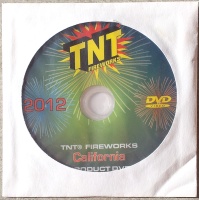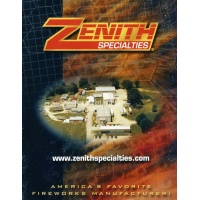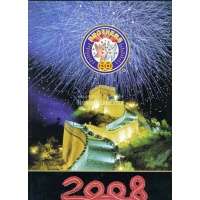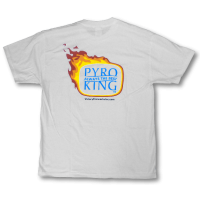"500-gram cakes" have already taken the consumer fireworks market by storm, so anything I say about them on this page isn't going to make a bit of difference. But this may help you understand the background regarding them and what people are talking about when they refer to them.
First of all, what is a "cake" in the first place? This term is used widely to mean multi-shot repeating aerial displays. The kind that have all the tubes fused internally and all you have to do is light the one external fuse, and you get 16, 25, 36 or any number of aerial shots fired sequentially and/or in groups. Some of these items were (and some today are) round in shape, and they resembled cakes, so the slang term "cake" became common. That term persists today even though very few cakes these days are actually cake-shaped.
Before the 500-gram cake specification was approved, the U.S. regulations for consumer fireworks stipulated that these devices could contain no more than 200 grams of pyrotechnic content (the powders and chemicals that actually produce the effects).
Some years back, the U.S. regulations were changed to allow these devices to contain up to 500 grams instead of 200, if the physical construction of the devices met certain specifications. I don't know what all those specifications are, but one of the requirements is that the individual tubes be spaced 1/2 inch apart, instead of right next to each other. I don't know the reasoning behind that 1/2 inch spacing requirement, but somebody somewhere must have had a reason for that. It has been suggested by a reader that the spacing is there to prevent "mass ignition," meaning preventing one tube from prematurely lighting other tubes (or all of them) and having the cake go off all at once.
This sounds to me like a plausible reason for the 1/2 inch spacing requirement, but I do not have any official verification of that. The 1/2 inch spacing requirement is partially responsible for the large, heavy bases used in may of these cakes, and is therefore partly to blame for the unweildy size and weight of many of the 500-gram cakes. Most 500-gram cakes are packed only 4 units to a case, though some are packed 3, 2 or even just 1 to the case. This unweildy size and weight means the cakes cost more to ship and take up more space in warehouses and on shelves, and all of this helps contribute to the high prices these cakes command.
There is a new trend among 500-gram cakes towards large tubes (even 3-inch diameter tubes) with nine of these tubes on a large, heavy base (usually a wooden base). I refer to these as 9-shot large tube cakes in my buyer's guide, but on some web sites they are called NOABs (short for Nine On A Board). These cakes often contain shells which produce very large breaks in the air.
In addition to the limit of 500 grams of total pyrotechnic content of the entire firework, there is also a limit on the effects of 40 grams per tube. The effect is the part that flies up in the air when ejected from the tube. This effect can contain up to 40 grams of pyrotechnic content (the powders and chemicals). The lift charge of each tube is limited to 6 grams. The lift charge is the small black powder charge which make the effect fly out of the tube. I believe that there is also a requirement that the tubes be mounted on a base, although the base is usually not visible because the entire item is wrapped in a brightly colored printed label. If you were to remove all the labeling you would discover that the tubes are mounted on a base rather than simply glued together.
When they made this change to the regulations, allowing up to 500 grams of pyro content, they basically created a new category of consumer fireworks. There are now two general categories of consumer multi-shot aerial displays in the U.S., the 200-gram cakes and the 500-gram cakes. There are still plenty of excellent quality 200-gram cakes on the market, so the introduction of 500-gram cakes does not make 200-gram cakes obsolete.
The prices for the "500-gram" cakes are high. Are they worth it? These are basically entire little firewoks shows that are pre-assembled for you, and all you have to do is plunk it down and light one fuse, and you get a whole little fireworks show that lasts maybe a minute or so. I do like the ones with angled tubes in them. My basic opinion about them is this: They are great if you want the convenience of having your shows already assembled for you, because all you have to do is buy them, line them up and light them - there's your fireworks show. It could hardly be any easier.
I have changed my view of 500-gram cakes recently. When they first came onto the market a few years ago, they were not particularly impressive, because the effects they had were nothing new - just larger and more of them in one cake. And they basically shot the effects one at a time, straight up, possibly with a speed-up for the last group of shots. At that time I thought that they were overpriced and that you could duplicate, more or less, the shows they produce, with a combination of 200-gram cakes and reloadable shells. The first generation of 500-gram cakes did not really live up to the hype surrounding the new category.
However, the manufacturers have concentrated a lot of effort on this particular category of fireworks in the past several years (possibly neglecting some other categories in the meantime). The result is that 500-gram cakes are a now major segment of the consumer fireworks market, with a wide selection available, including high quality effects and interesting arrangments of the tubes and the way they are fused internally. You can find 500-gram cakes which fire shots straight up, or at angles, in groups of several shots called fans, or in a zig-zag sequence (either slowly or very rapidly), and even now in a circular sequence. 500-gram cakes have continued to become more sophisticated, both in the effects and in the arrangments of the tubes and the firing sequences. They are still relatively expensive, though, compared to other categories of consumer fireworks. But after several years of production they have finally realized the potential that was made possible by the creation of this category.
Do the 500-gram cakes have a longer performance duration than the 200-gram cakes do, or are they just bigger? There is wide variety among the 500-gram cakes as to how long the performance lasts. Depending on how many shots are in the cake, and how they are fused internally, 500-gram cakes can be as short as 15 seconds and as long as 3 minutes. The statistical average of the 208 500-gram cakes that I have seen is about 45 seconds. But this is only the average; there is wide variation. Compare this to the statistical average of the 1,210 200-gram cakes that I have seen, whic is about 29 seconds. So, in very general terms the 500-gram cakes typically last 50% longer in duration than the 200-gram cakes do. But a few 200-gram cakes last longer than some 500-gram cakes. Everything depends on the number of shots in the cake and the type of fuse and method of fusing that is done on the inside by the manufacturer.
If you have a large budget, certainly include some of the 500-gram cakes as part of your show. They really can save you a lot of time and work in setting up displays with angled tubes and firing sequences that would take you a lot of effort to produce on your own. The newer NOABs (discussed in the 7th paragraph above) often produce enormous breaks in the air. But don't forget the 200-gram cake category - there are still many excellent cakes which conform to the 200-gram limits and are definitely worth buying as well. And budget some of your money for the reloadable shell kits - many of the best and largest breaks you will get in the air come from those reloadable shells.
Copyright © Bob Weaver. All rights reserved.







